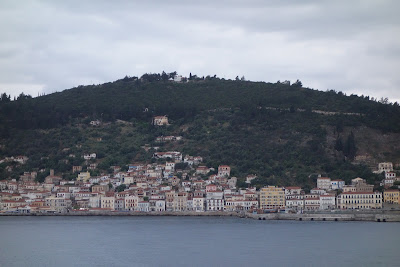A stop in the port
city of Gythion, Greece was next on the agenda.
We’re now exploring the west side of the Peloponnese overlooking the
Ionian Sea.
Pat told me the last blog
was "pretty heavy." So I’ll make it a point
to lighten up with the Roman Legions and Sparta infantry looming large. First
stop …
MYSTRAS
This medieval town
developed around 1250 AD and overlooked ancient Sparta. Although Mystras was eventually abandoned,
what remains is a spectacular UNESCO World Heritage Site.
Located about 30 mile
north of Gythion, we made our usual bus trek around mountainous terrain past
Sparta to our destination. Sitting in
the back row in the middle gives you a unique perspective through the
windshield. Wish I could have captured it
as a movie. That way all of you too could have enjoyed the swaying ... the side to side to side to
side to side … motion of the uphill climb, sans the many bumps.
Mystras is a site of ancient
fountains, great vaulted halls and fine frescoes which depict various aspects of
this Byzantine town.
Across the valley you
can see the current town of Sparta.
SPARTA
As far as ancient
Sparta goes, I’m going to asked that you engage the imagination you enjoyed as
a child. Only a few remains and a
statute of Leonidas mark the spot of the once great and leading power of
Greece.
It seems Sparta’s ruins were not
embellished and not worth the cost of much excavation and restoration … they
were after all – “spartan.”
As much as the Athenians
loved the humanities, the ancient Spartans loved (or at least prepared themselves
for) war. Young boys were conscripted into the infantry at age 6 to learn the science of war.
If that isn’t tragic enough, the guide reported that a high rock
across the valley was where the children with mental or physical disabilities
were cast off. How ‘bout that for lightened
up.
I mentioned in the
prior blog that Sparta was victorious in the Peloponnesian Wars against Athens.
It was not so lucky against the invading
Romans, however, and lost its political stature and independence during the Roman
conquest of Greece in 146 BC. This once
powerful city state went into decline and with many of its citizens moving to
Mystras during the Middle Ages never emerged again.
Tomorrow we're in Rome. So under advice of counsel I'll talk about La Dolce Vita.






I love your blogs: educational and so entertaining! You would have a GREAT teacher!
ReplyDeleteManon